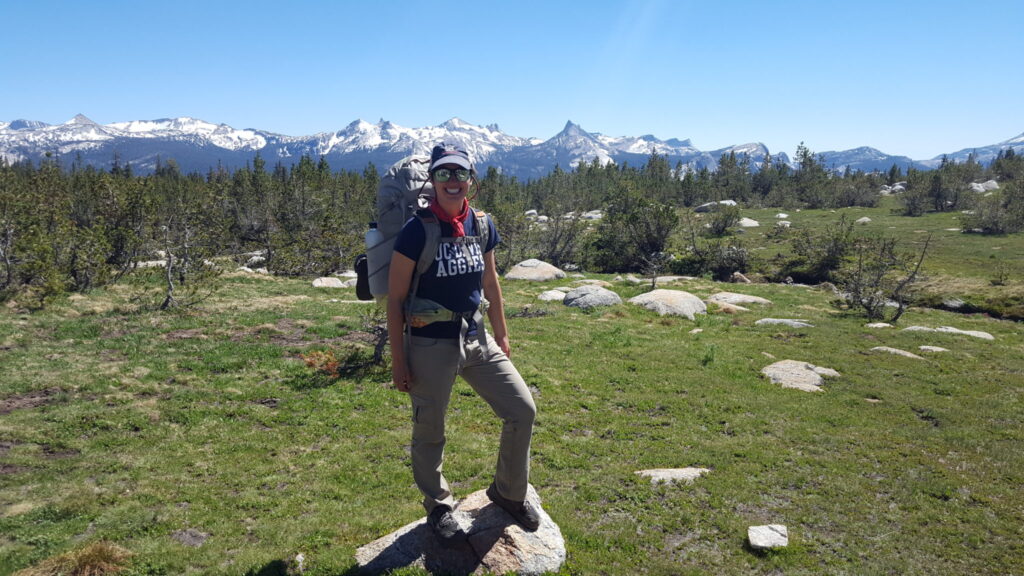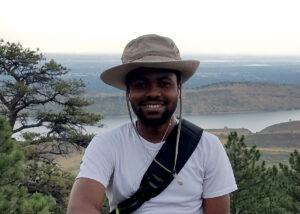
Every career in science begins differently.
Christophe Wakamya Simbo’s dream of being a geologist began when he was a child in the Democratic Republic of the Congo, where the African continental crust has been splitting for millions of years.
“Seismic and volcanic activities were the first geological hazards and wonders and encounters that first sparked my interest in geology,” he said.

A doctoral candidate in the geosciences department at Colorado State University, Simbo is finishing his dissertation while working as a geochemist at a geothermal energy company.
Emily Iskin’s journey as a scientist began when she started asking “why.” Her first career was in civil engineering, but she knew it was time for a change when she realized she wanted to get out of the office and into nature.
“I found myself asking a lot of whys. I had bigger questions than the engineering consulting world allowed,” Iskin said.
To answer those bigger questions, Iskin came to study at CSU, and received her masters and doctoral degrees in geosciences. After completing the doctoral program in 2023, she was hired at Boise State University as a postdoctoral researcher, where she studies beaver restoration on rivers.
Publishing research as a graduate student
Advancements in science depend on free exchange of information and ideas, and academic journals are often an essential platform for researchers to communicate about discoveries.
To start their careers as scientists, Simbo and Iskin had to learn as graduate students to publish their research as articles in academic journals.
“To be legitimate as a scientist, especially as a graduate student, you have to publish,” said Iskin.
Publishing early in a scientist’s career, especially during graduate school, is becoming increasingly important.
“Research and publishing are often regarded as critical metrics of a graduate student’s productivity, success and professional outcome,” Simbo said.
One challenge to sharing research findings is that publishers often restrict access to articles and require would-be readers to pay. A common way to access scientific research is through university libraries, which pay for access on behalf of their communities.
Making research free through open access, at a cost
However, there is a movement toward “open access” publishing to make articles freely available online to anyone. With open access, Iskin explains, “There’s not a door between you and the science.”
She added: “Open access allows everyone to engage in science. It’s not gatekeeping. It’s like, ‘we’re all doing this research, let’s talk about it!’”
As graduate students, Simbo and Iskin wanted to publish their research as open access, because it could mean potentially reaching more readers and increasing the impact of their research.
There was a hitch, though. Many journals require authors to pay to make their paper open access. So the choice Iskin and Simbo faced was either to pay hundreds of dollars to make their research freely available, or pay nothing to put their research behind a paywall.
Enter the CSU Libraries. Like other academic libraries, the Libraries has opted to help students and researchers by paying some open access fees out of its own budget.
Because the Libraries paid the publishing fee, Iskin and Simbo were able to make a different choice than most graduate students.
“I [didn’t] have to choose between my values of open access and the publishing we have to do,” said Iskin.
To pay on behalf of CSU authors, the Libraries negotiated with publishers to create special agreements, “transformative agreements,” which combine subscription fees to access content with the cost of open access publishing. However, due to high demand, these funds are sometimes quickly depleted.
To help authors navigate the complexities of open access publishing, librarians and data experts at the Libraries work closely with authors. Khaleedah Thomas, copyright and scholarly communications librarian, helped Simbo as he was finalizing his articles.
“Khaleedah’s expertise on open [access] greatly facilitated the process,” Simbo said.
Sharing is caring in a scientific community
Being part of a community of researchers freely sharing information can lead to strong support networks and encourage creativity.
Simbo pointed to his experience reading his peers’ work and reaching out for guidance from other researchers.
“This collaborative approach not only stimulated my imagination but also fostered a sense of community and mutual aid within academia,” he said.
“Open access publishing facilitates greater accessibility to researchers worldwide, which can lead to increased citations and recognition within the international academic community,” Simbo said. He added that he was contacted by a potential employer because his open access research had attracted their attention.
Although publishing as a graduate student can be difficult, Simbo has encouraging advice for his fellow graduate students: “Navigating a graduate program is undeniably mentally demanding and exhausting,” he said. “There will be challenging times and you are meant to inevitably pass through them to earn your dream.”